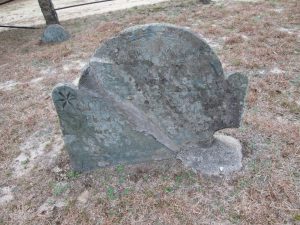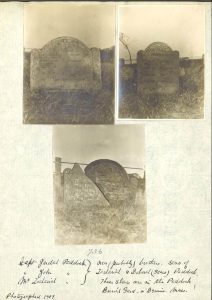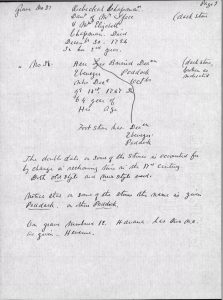
Because of the dedication of our many volunteers, we at the New England Historic Genealogy Society have the opportunity to continually expand the range of databases we provide to family researchers. Recently we have made a lot of progress indexing cemetery transcriptions from NEHGS manuscripts, creating a database complete with accompanying images. You may wonder why we are bothering to index these old manuscripts when there are so many other sources of cemetery information widely available on the Internet today.
I am sure that many of us have taken advantage of free internet resources to extend our family histories with invaluable cemetery information. The most well-known providers are probably Find a Grave and Billion Graves. Find a Grave currently reports having over 154 million records online.[1] Billion Graves declares that they are “the world’s largest resource for searchable GPS cemetery data.”[2] It can be wonderfully satisfying to go to one of these sites and track down an actual image of the gravestones of your ancestors, especially when they are geographically distant.
Of course, NEHGS is not trying to compete with sites like these. Those sites have their own volunteers capturing pictures and posting them every day. However, there is still an important value in publishing the information from the NEHGS manuscripts. The simple reason is that we are losing gravestones every day. Unfortunately, in many places you can visit a cemetery and find that many old markers are severely worn or damaged. On many once-beautiful slate markers the engraved surface layers have completely flaked away, and all that remains for us to see is a blank grey slab of stone.
This is not a new problem. In 1899 the NEHGS Council started recruiting members to record cemetery inscriptions in the ancient burying grounds in New England.[3] Members responded by visiting their local cemeteries and donating the results of their hand-written or typewritten work to the NEHGS manuscripts collection. These manuscripts dating from the turn of the last century can be invaluable when markers have been buried, broken, or faded away.
Given this value, this we have recently made available a database titled North American Cemetery Transcription from NEHGS Manuscripts.[4] This database has all of the names and dates indexed, and includes access to images of the original manuscripts.
One enterprising author augmented their manuscript, which was written in 1909, with some photographs. This particular volume is titled “MA, Barnstable: East Dennis – Paddock.” One of these pictures provides us an excellent example for the value of transcriptions dating back over 100 years. The first picture, above, shows the image available today from Find a Grave for one Ebenezer Paddock. You can see that maker had broken. In addition to the weathering and lichen on this stone, a rather crude attempt at repairing the diagonal crack with cement makes it rather difficult to read anything at all.
 The next image is the manuscript photograph from 1909 (at the bottom of the page). In this image, we can see that the marker has the same split, but there is much less wear and the engraving is not obscured by the repairs.
The next image is the manuscript photograph from 1909 (at the bottom of the page). In this image, we can see that the marker has the same split, but there is much less wear and the engraving is not obscured by the repairs.
 Then in the final image we have the hand-written transcription of Paddock’s marker, complete with a simulated crack running through the transcription.
Then in the final image we have the hand-written transcription of Paddock’s marker, complete with a simulated crack running through the transcription.
Photographs are a rarity in this database, but the real value is the text from the thousands of markers that have been painstakingly transcribed. These are available to us today, even for the gravestones that are no longer available.
I’d like to send my thanks both to the NEHGS volunteers who undertook the task of capturing so much information over a hundred years ago, and to our modern-day volunteers whose careful indexing of these records makes them available to everyone.
Notes
- Find A Grave, findagrave.com/index.html
- Billion Graves, billiongraves.com/
- Helen Herzer, Tiptoe through the tombstones, at Vita Brevis
- NEHGS, North American Cemetery Transcriptions from NEHGS Manuscripts
- Find a Grave entry for Ebenezer Paddock
This is wonderful. Thanks to all.
Thank you for increasing awareness on this important issue. Regardless of material and preservation, the stones and paper records just won’t last forever.
In researching, I’ve always compared as many transcriptions as I can find, since they usually differ. Transcription details and the listing order can differ.
Old pictures can be very revealing. In areas such as Tennessee where I live, cemeteries can be on old family farms and infrequently maintained. Old photographs from the 1930s, as an example, can show a very different landscape from today.
A similar issue happens with family Bibles. I transcribed one about 20 years ago, and the original ink has now degraded significantly in spite of good care.
I thank you too. I have seen early 20th Century transcripts of graves in various cemeteries and then the actual headstone, and the headstone can no longer be read. I know that is true for many ancient headstones in New England. It is now the transcripts which have the data.
I photographed the gravestone of my Athearn 8x great-grandmother, Mary (Butler) Athearn, three years ago when I was on Martha’s Vineyard. Sadly the face has entirely sheared off, and it is identifiable only in context, between those of her husband and son-in-law. I was thrilled to find a photograph of the gravestone as it looked circa 1900, when it was photographed by Edward Lee Luce, a local amateur photographer whose work is now available online. The details and inscription are perfect: HERE LYES BURIED THE BODY OF Mrs. MARY ATHEARN RELICT TO Mr. SIMON ATHEARN DECd. Ye 8th. DAY OF APRIL A.D: 1741 IN THE 90th. YEAR OF HER AGE. Needless to say, it was very exciting to be able to see not only what the gravestone had looked like for at least 150 years, but all its valuable information. I wish there were a way to share the pictures, because the difference it quite striking!
It looks someone aready posted a picture in Find a Grave – see http://tinyurl.com/jtvj4g5. If this is not the right one, you can add your picture there.
Thank u 4 ur examples of what u r talking about. It makes so much more sense when shown. Ur work along with everyone else’s is greatly appreciated.
“Find A Grave” members steal content from the Internet. Do not promote them..
This is another reason I am so glad I am a member of NEHGS. Thank you.
Great work Donald LeClair!
It’s so exciting to have this new source of information. I just returned from a trip that involved visiting four different cemeteries in Ohio. Some of those stones will no longer be legible in a few years. I’m very grateful for all the work that volunteers do to keep this information available.
I am immensely grateful to the folks who put so much effort into photographing gravestones and memorials and posting them, and to the people who here in Vermont in the mid to late 20th century transcribed the legends and published them for the future. Most communities have copies of these books in the local libraries. Because of them, I have access to records of several generations of several of my ancestral lines buried at the same cemetery. Several hundred people whose stones were badly damaged by improper cleaning. Not only are most not readable, a great many are simply blank pieces of deteriorating stone. When I went to visit, I was stunned, and felt bereaved. Luckily, a few weeks later, I visited another cemetery with another of my lines. I was happy to see intact tombstones and readable inscriptions. Though some stones were damaged, the community takes care of the cemetery, and have made efforts to responsibly repair damaged stone. It was a beautiful place to visit.
My great grandfather, Charles Somers Miller, made records of grave stone inscriptions much of his life, as mentioned in his journals (online at http://ccat.sas.upenn.edu/rak//gen/miller/journals.htm). Probably those records have survived with his papers in my possession, but I have not yet found them. Some transcriptions are included in the aforementioned journals — search for “cemeter” and “grave stone” and “inscription” and the like. He was also active in repairing stones and generally maintaining local cemeteries in the Waterbury CT area.
PS. In his journals, Charles Somers Miller often spelled cemetery with “-ary” instead of “-ery,” so searching cemetary will be rewarding as well, since the online transcription attempts to represent the actual text of the journals. Some editorial intervention needs to be added regarding such problems, while still retaining the original — e.g. use of brackets for “corrections” to assist with accurate searching.
It is wonderful that your great grandfather did that work. If you should find those papers and would like to share them with NEHGS, we would definitely appreciate it!
NEHGS links are dead. Thank you.